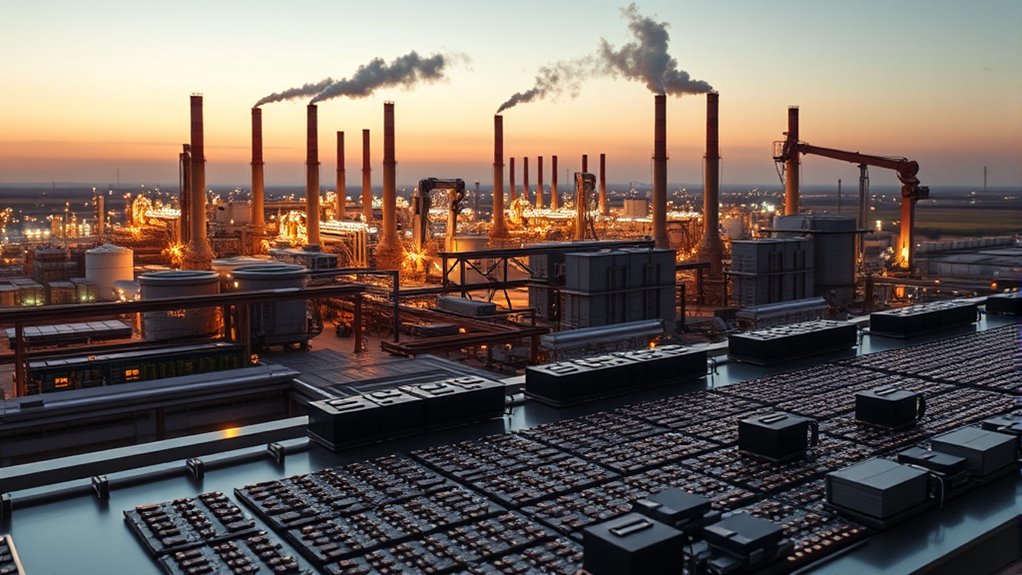Europe is revolutionizing its industrial landscape by heavily investing in critical sectors like chips and batteries to reduce reliance on external suppliers and secure its technological future. By focusing on innovation funding, strengthening supply chains, and fostering regional cooperation, Europe aims to become a global leader in advanced manufacturing. This strategic shift enhances resilience, promotes sustainability, and positions Europe at the forefront of technological growth. To discover how these initiatives could impact you, explore the full scope of Europe’s industrial ambitions.
Key Takeaways
- Europe is investing heavily in semiconductor and battery sectors to establish global leadership and reduce reliance on external suppliers.
- Strategic funding supports innovation and commercialization of advanced technologies in chips, energy storage, and related industries.
- Supply chain resilience is prioritized through regional hubs, stockpiles, and diversified sourcing strategies.
- The policy emphasizes fostering startups and collaborations among academia, industry, and governments for technological breakthroughs.
- Overall, Europe aims to build a self-reliant, competitive industrial ecosystem focused on innovation, sustainability, and global market leadership.

What does Europe’s industrial policy mean for its future competitiveness? It’s a question that’s central to understanding how the continent plans to stay ahead in a rapidly changing global economy. At its core, Europe aims to strengthen its industrial base by reducing dependence on external suppliers and boosting domestic production. This strategy emphasizes supply chain resilience, guaranteeing that disruptions—like those experienced during the pandemic—don’t cripple key sectors. By diversifying suppliers and investing in local manufacturing capabilities, Europe can better withstand shocks and maintain steady growth. But resilience alone isn’t enough; innovation funding plays an essential role in this effort. The continent is channeling significant resources into research and development, encouraging tech startups, and supporting established industries to adopt cutting-edge technologies. This dual focus on supply chain robustness and innovation helps create a competitive edge, enabling Europe to produce high-quality, advanced products that can compete globally.
Europe’s push for strategic investments in sectors like chips and batteries isn’t just about catching up—it’s about leading. By prioritizing innovation funding, the continent fosters breakthroughs in semiconductor manufacturing and energy storage, positioning itself as a leader in these critical industries. This approach ensures that European companies don’t fall behind in the technological race, and it creates a fertile environment for startups and established firms alike to develop the next generation of products. Furthermore, these investments are often coupled with industrial policies aimed at fostering collaboration between academia, industry, and governments. Such partnerships accelerate innovation, turning promising ideas into commercially viable solutions faster than ever before.
The emphasis on supply chain resilience also means Europe is actively reconsidering its sourcing strategies. It’s not just about bringing manufacturing home but making those supply chains more flexible and adaptive. This might involve creating regional hubs or stockpiling critical components, so industries aren’t left vulnerable if global trade encounters obstacles. With this approach, Europe aims to reduce its vulnerability to geopolitical conflicts, trade disputes, or unforeseen crises, ultimately safeguarding its economic stability. Additionally, the focus on fostering industrial ecosystems enhances regional cooperation and technological development, further strengthening Europe’s industrial competitiveness.
In short, Europe’s industrial policy signals a strategic shift towards building a more self-reliant, innovative, and resilient industrial ecosystem. By investing heavily in innovation funding and reinforcing supply chain resilience, it’s setting the stage for sustainable growth and global competitiveness. If successful, this policy will not only secure Europe’s economic future but also position it as a global leader in advanced manufacturing and technological innovation.
Frequently Asked Questions
How Will Europe’s Industrial Policy Impact Global Trade Dynamics?
Your country’s trade dynamics will shift as Europe’s industrial policy reshapes global supply chains. You might see new trade negotiations emerge, aiming to secure strategic partnerships and access to key markets. Europe’s focus on chips, batteries, and advanced technologies could lead to increased competition, affecting prices and availability worldwide. You’ll need to stay adaptable, as these changes will influence how goods move, impact global trade flows, and redefine economic alliances.
What Are the Environmental Implications of New Chip and Battery Manufacturing?
You might find that new chip and battery manufacturing can impact the environment through increased resource consumption and waste. However, if you focus on sustainable manufacturing practices and resource conservation, these impacts can be minimized. By adopting eco-friendly technologies and efficient resource use, you help reduce pollution and energy use, ensuring that production supports environmental health while meeting industry demands. This balance is essential for long-term sustainability.
How Does Europe’s Policy Compare to U.S. and China’s Industrial Strategies?
You’ll find that Europe’s strategy emphasizes sustainable growth through targeted industrial subsidies and fostering strategic alliances. Unlike the U.S., which heavily invests in innovation and military tech, Europe prioritizes environmental standards and cooperation. China, on the other hand, leverages massive subsidies and state-led initiatives to dominate global supply chains. Your perspective highlights how Europe’s collaborative approach aims for balanced growth, contrasting with the more aggressive tactics of the U.S. and China.
What Funding Mechanisms Support Europe’s Industrial Initiatives?
You’re supported by various funding sources and financial instruments that back Europe’s industrial initiatives. These include grants from the European Union, such as Horizon Europe, and loans or guarantees from European Investment Bank. Additionally, public-private partnerships and innovation funds help finance research and development projects. By leveraging these diverse funding mechanisms, Europe aims to bolster its industrial competitiveness, foster innovation, and ensure sustainable growth across key sectors like chips and batteries.
How Will Small and Medium-Sized Enterprises Benefit From These Policies?
Small and medium-sized enterprises will notably benefit from these policies by boosting SME innovation and strengthening local supply chains. You’ll find more funding opportunities, fostering growth and competitiveness. These initiatives support your ability to innovate in niche markets and localize production, reducing reliance on distant suppliers. As a result, you’ll experience increased resilience, faster access to new technologies, and enhanced market agility, positioning your business for sustainable success in Europe’s evolving industrial landscape.
Conclusion
Think of Europe’s industrial policy as planting a seed in fertile ground. With strategic investments in chips, batteries, and beyond, you’re nurturing a future where innovation blossoms. Stay committed, and you’ll see this garden grow into a resilient forest, strengthening your economy and securing your place in global markets. Remember, patience and persistence are your tools—trust the process, and soon, you’ll reap a harvest of sustainable growth and technological prowess.









